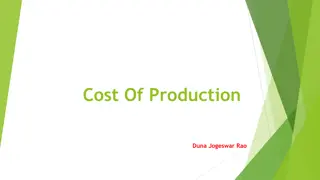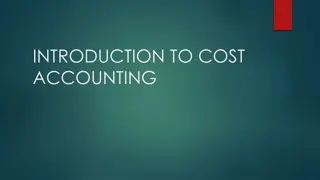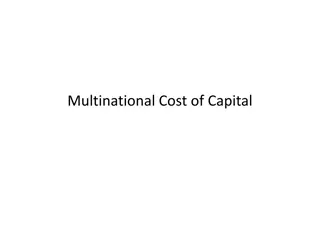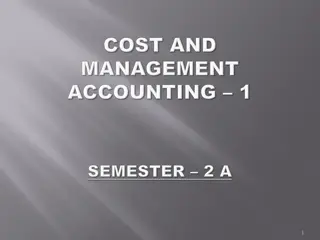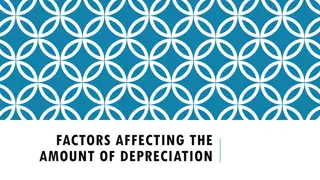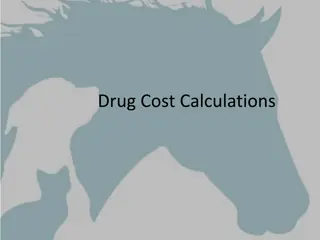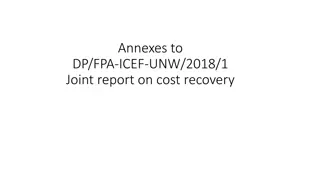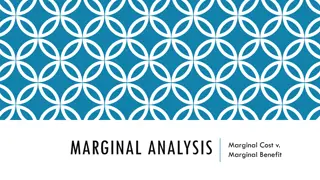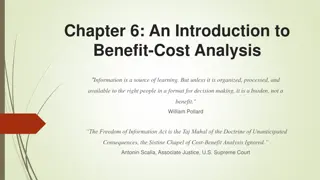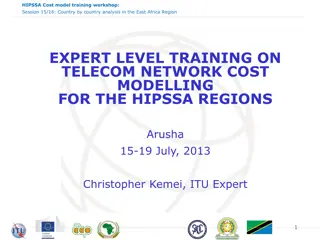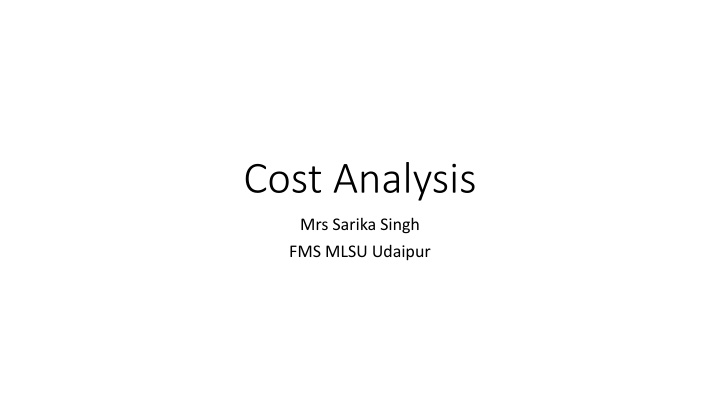
The Significance of Cost Analysis in Business Decision Making
Cost analysis is a crucial aspect of business decision-making, influencing production management, cost minimization, output optimization, pricing strategies, and operational cost estimation. The concept of opportunity cost, economic cost, implicit cost, accounting cost, and private versus social costs are discussed to provide a comprehensive understanding of different cost types in business.
Download Presentation

Please find below an Image/Link to download the presentation.
The content on the website is provided AS IS for your information and personal use only. It may not be sold, licensed, or shared on other websites without obtaining consent from the author. If you encounter any issues during the download, it is possible that the publisher has removed the file from their server.
You are allowed to download the files provided on this website for personal or commercial use, subject to the condition that they are used lawfully. All files are the property of their respective owners.
The content on the website is provided AS IS for your information and personal use only. It may not be sold, licensed, or shared on other websites without obtaining consent from the author.
E N D
Presentation Transcript
Cost Analysis Mrs Sarika Singh FMS MLSU Udaipur
Cost analysis assumes a great significance in all major business decisions because the term cost has different meaning under different settings and is subject to varying interpretations.
The analysis of cost is an important factor in almost all business analysis and business decision making like a)The weak points in the production management. b) Minimizing the cost. c) Finding the optimum level of output. d) Determining price and dealers; margins. e) Estimating or projecting the cost of operation.
COST CONCEPT & TYPES OPPORTUNITY COST Opportunity cost of a product is value of the next best alternative forgone (that is not chosen). It can also defined as the revenue forgone for not making the best alternative use. The concept of opportunity cost is useful for manager in decision making.
ECONOMIC COST This cost includes explicit and implicit cost both. In other words, economic cost includes both recorded and unrecorded cost. EXPLICIT COST is the actual money expenditure on inputs or payments made to the outsiders for hiring the factor services. Example wages paid to employees, payment for raw materials etc.
IMPLICIT COST is the cost of selfsupplied factors . Example- Interest on own capital ,Rent of own land etc. The sum of explicit cost and implicit cost is the total cost of production of a commodity.
ACCOUNTING COST Accounting cost is the cost based upon accounting records in the book of accounts. They are recorded in the book of accounts when they are actually incurred . Its based on Accrual concept. Accounting costs are explicit cost and must be paid.
PRIVATE COST & SOCIAL COST Private costs are those which are actually incurred by a firm on the purchase of goods and services from the market. For a firm, all actual costs both explicit and Implicit are private costs. Social Costs refers to the total cost borne by the society due to production of a commodity
Incremental and Sunk Costs Incremental costs are closely related to marginal costs, incremental costs refers to the total additional cost associated with the expand in output. Sunk Costs are those which cannot be altered, increased or decreased by varying the rate of output.
Short Run and long run costs Short run costs are costs that vary with variation in output. Short run costs are the same as variable costs Long run costs are costs that are incurred on fixed assets like plant, machinery, etc
DIRECT AND INDIRECT COST Direct cost are the costs that have direct relationship with a unit of operation. This includes items such as software, equipment, labor and raw materials. Indirect cost are those cost whose cost can t be easily traced to a product such as electricity , stationary and other office expenses.
TOTALCOST Total cost is the actual money spends to produce a particular quantity of output. It is the summation of fixed and variable costs TC = TFC+ TVC TFC(Total Fixed Cost): Total fixed costs, i.e the cost of plant, building, equipment etc. remain fixed with a change in output. TVC(Total Variable Cost): The total variable cost i.e the cost of labour, raw material etc varies with the variation in output.
AVERAGECOST Average cost is the total cost of producing per unit of commodity. It can be found out as follows AC= AFC+AVC AC= Total cost/no.of units produced AFC (Average fixed Cost)- Fixed cost of producing per unit of the commodity. AFC= total fixed cost / no. of units produced. AVC (Average Variable Cost) Variable cost of producing per unit of the commodity. AVC= total fixed cost / no. of units produced.
MARGINAL COST Marginal cost is the additional to total cost when one more unit of output is produced. It can be arrived by dividing the change in total cost by the change in total output. TC MC = Q
Cost-output Relationship Cost-output relationship has 2 aspects: Cost-output relationship in the short run, Cost-output relationship in the long run The SHORT RUN is a period which doesn t permit alterations in the fixed equipment (machinery , building etc.) & in the size of the org. The LONG RUN is a period in which there is sufficient time to alter the equipment (machinery, building, land etc.) & the size of the org. output can be increased without any limits being placed by the fixed factors of production
Cost-output Relationship In The Short Run
SHORT RUN COSTS Average Fixed Cost Average VariableCost Average Totalcost
Total, average & marginal cost TC) = TFC + TVC, rise as output rises 1.Total cost (TC) = TFC + TVC, rise as output rises 2. Average cost (AC) = TC/output 3. Marginal cost (MC) = change in TC as a result of changing output by one unit Fixed cost & variable cost 1.Total fixed cost (TFC) = cost of using fixed factors = cost that does not change when output is changed, e.g. 2.Total variable cost (TVC) = cost of using variable factors = cost that changes when
Average Fixed Cost and Output The greater the output, the lower the fixed cost per unit, i.e. the average fixed cost. Total fixed costs remain the same & do not change with a change in output. Average Fixed Cost and Output The greater the output, the lower the fixed cost per unit, i.e. the average fixed cost. Total fixed costs remain the same & do not change with a change in output.
Average Total cost and output Average total cost, also known as average costs, would decline first & then rise upwards. Average cost consists of average fixed cost plus average variable cost. Average fixed cost continues to fall with an increase in output while avg. variable cost first declines & then rises. So , as Avg. variable cost declines the Avg. total cost will also decline. But after a point the Avg. variable cost will rise. When the rise in AVC is more than the drop in Avg.
RELATIONSHIP BETWEEN MARGINAL AND AVERGAE COST The marginal costs and average costs are related. When marginal cost exceeds average cost, average cost must be rising. When marginal cost is less than average cost, average cost must be falling. The position of marginal cost relative to average total cost tells us whether average total cost is rising or falling.
Relationship between Marginal Cost and Average cost If MC>ATC, then ATC is rising If MC>MVC , then AVC is rising If MC< ATC, then ATC is falling If MC<AVC, then AVC is falling If MC=AVC and MC=ATC, then AVC and ATC are at there minimum points
Long Run Costs They are costs over a long period of time. They permit for enough change in all factors of production. Thus firms can produce more. Supply of a commodity is adjusted to its demand.
Long Run Cost Curve All costs are variable in the long run. There are only average variable cost in long run, since all factors are variable. It is also called as planning curve or envelope or scale curve.
Production Rules for the Long Run If selling price > ATC (or TR > TC): Continue to produce. Maximize profit by producing where MR = MC. If selling price < ATC (or TR < TC): There will be a continual loss. Sell the fixed assets to eliminate fixed costs. Reinvest money is a more profitable alternative.
Factors determining the cost are Size of plant: There is an inverse relationship between size of plant and cost. As size of plant increases, cost falls and vice versa. Level of Output: There is a direct relationship between output level and cost. More the level of output, more is the cost ( i. e., total cost) and vice Versa. Price of Inputs: There is a relationship between price of inputs and cost. As the price of inputs rises, cost ruses and vice versa.
State of technology: More modern and upgraded the technology implies lesser cost and vice versa. Management and administrative efficiency: Efficiency and cost are inversely related. More the efficiency in management and administration better will be the product and less will be the cost. Cost will case of inefficiencies in management and administration.
B Break reak- -even evenanalysis analysis Break-even analysis or what is also known as profit contribution analysis is an important analytical technique used to study the relationship between the total costs (TC), Total revenue (TR) and total profits and losses over the whole range of stipulated output. The breakeven analysis is a technique of having a preview of profit prospects and a tool of profit planning. It integrates the cost and revenue estimates to ascertain the profits and losses associated with different levels of output.
To illustrate the break-even analysis under linear cost and revenue conditions, let us assume linear cost and linear revenue functions are given as follows. Cost function: TC = 100 + 10 Q ..eq. (1) Revenue function: TR = 15 Q .. eq. (2) The cost function given in eq. (1) => firm s TFC (total fixed cost) = varies at a constant rate of increase in output. The revenue function given in fig. implies that price for the firm s product is given in the market at 15 per unit of sale. 100 and its variable cost 10 per unit in response to
Break-even Analysis : LinearFunction y 700 TR 600 Operating profit Cost and revenue TC 500 400 TVC Operating Loss B 300 200 TFC 100 x 0 30 10 40 20 output
The line TFC shows the total fixed cost at 100 for a certain level of output. The line TVC shows the variable cost rising with a slope. The line TC has been obtained by plotting the TC function. The line TR shows the total revenue. The line TR & TC lines intersect at point B At point B, Q = 20 ;firm s total cost =total revenue At Q=20, TC breaks-even with TR. Point B, therefore the break-even point and Q= 20 is break-even output.
Below this level of output, TC exceeds TR. Vertical difference TC-TR known as operating loss. Beyond Q=20, TR>TC and TR-TC is known as operating profit. It may be noted that a firm producing a commodity under cost and revenue conditions given in above eq. (1) & (2). Must produce at least 20 units to make its total cost and total revenue break-even. At break-even point, TR = TC
Breakeven analysis under non-linear function
Breakeven analysis under non-linear function y TC B2 TR Total cost and revenue B1 F TFC x Q2 Q1 0 Output per time unit
TFC line shows the fixed cost at OF and the vertical distance between TC and TFC measures the total variable cost (TVC). The curve TR shows the total revenue at different output & price. The vertical distance between the TR and TC measure profit/loss. TR & TC curves intersect at two points, B1 & B2, where TR = TC. OQ1 corresponding to break-even point B1 and OQ2 corresponding to break-even point B2 ;TR > TC. Profitable range lies between OQ1 and OQ2 units of output.

